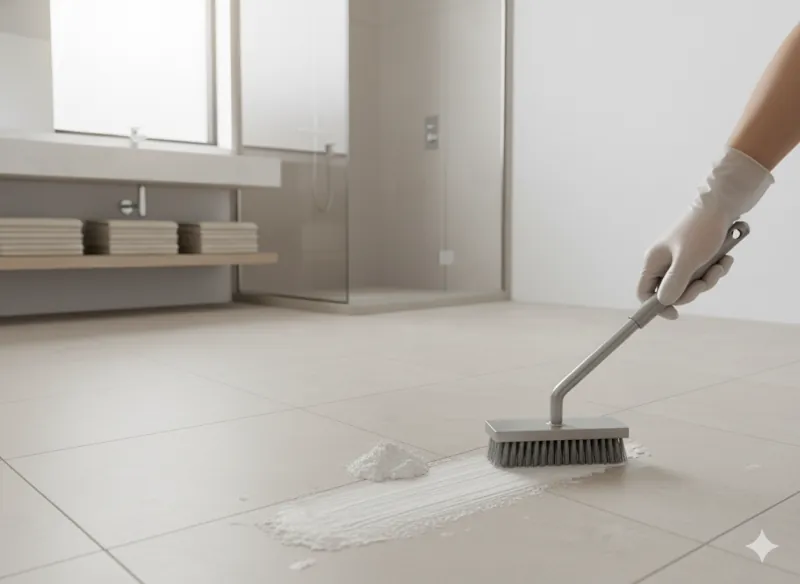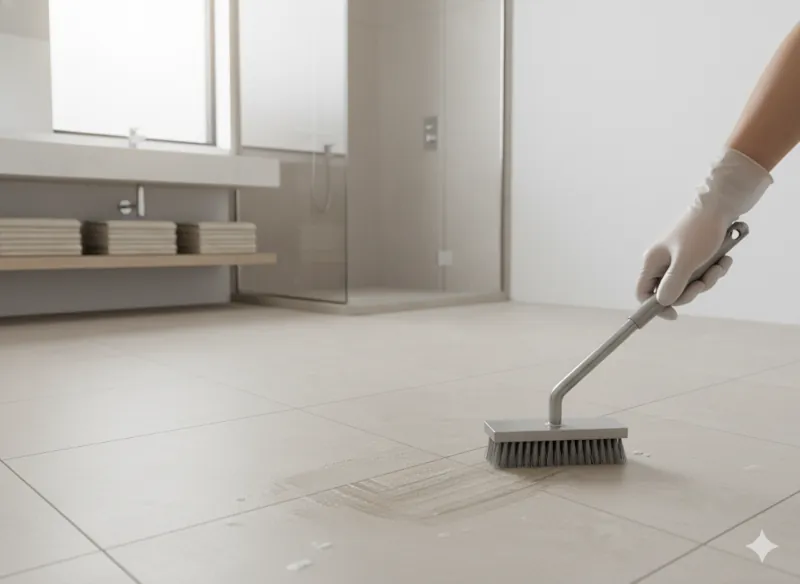
Let’s be honest—dirty grout lines can make even a freshly cleaned bathroom look grimy. The tiles may shine, the mirror may sparkle, but those dark, dingy lines between tiles steal the show (and not in a good way).
I still remember when I moved into my first apartment. The bathroom tiles looked fine… until I noticed the grout around the shower floor. It had turned from white to dark gray, almost black. I tried mopping and spraying random cleaners, but nothing worked. Eventually, I learned that grout requires special care, and once I used the right method, the transformation was unbelievable.
This guide will walk you through how to clean bathroom tiles and grout, which tools to use, natural vs. chemical options, and how to keep them spotless for the long term.
👉 For a full cleaning routine, don’t miss our Bathroom Cleaning Master Guide.
Why Tiles and Grout Get Dirty
- Porous grout. Grout absorbs water and soap, making it prone to mold and discoloration.
- Soap scum buildup. Shampoo and body wash cling to both tiles and grout.
- Hard water stains. Minerals in water leave white spots and cloudy streaks.
- High traffic areas. Shower floors and sink backsplashes get dirty faster.
💡 Tiles are like the skin of your bathroom, but grout is its memory—it shows every bit of dirt and moisture that passes by.
Supplies You’ll Need
- Baking soda.
- White vinegar.
- Hydrogen peroxide (for stubborn stains).
- Scrub brush or old toothbrush.
- Microfiber cloths.
- Spray bottle.
- Rubber gloves.
- Optional: grout sealer (to prevent future stains).
👉 For recommended tools, see our Best Bathroom Cleaning Supplies & Tools.
Step-by-Step: How to Clean Bathroom Tiles
1. Basic Surface Cleaning
- Mix warm water + a few drops of dish soap.
- Wipe tiles with microfiber cloth or mop.
- This removes dust and surface dirt before deep cleaning.
2. Remove Soap Scum & Hard Water Spots
- Spray vinegar solution (vinegar + water, 1:1) on tiles.
- Let sit for 5–10 minutes.
- Wipe with microfiber or sponge.
💡 For heavy buildup, sprinkle baking soda on a damp sponge and scrub gently.
3. Shine Tiles with a Squeegee
- After every shower, run a squeegee over wall and floor tiles.
- Prevents spots and reduces weekly cleaning time.
Step-by-Step: How to Clean Grout
1. Apply Baking Soda Paste

- Mix baking soda + water into thick paste.
- Apply directly onto grout lines.
2. Spray with Vinegar
- Spray vinegar solution over paste.
- Let fizz for 5–10 minutes (it lifts dirt).
3. Scrub with Brush

- Use stiff brush or toothbrush to scrub grout.
- Work in circular motion for best results.
4. Rinse with Warm Water
- Wipe clean with microfiber cloth.
- Check for remaining stains.
For Stubborn Grout Stains
- Mix hydrogen peroxide + baking soda (paste).
- Apply on grout lines.
- Let sit 15 minutes, scrub, and rinse.
⚠️ Avoid bleach unless grout is sealed and ventilation is good—it can weaken grout over time.
Preventing Future Grout Problems
- Seal grout. Apply grout sealer every 6–12 months to block moisture.
- Ventilate bathroom. Use exhaust fan after showers.
- Daily wipe-down. Keep microfiber cloth handy to dry wet spots.
- Declutter floor & shelves. Fewer bottles = less residue on grout.
👉 For more preventive habits, check our Bathroom Cleaning Checklist.
Eco-Friendly Cleaning Options
- Vinegar + baking soda: natural, effective combo.
- Lemon juice: works for mild stains and adds fresh scent.
- Steam cleaner: uses only water, no chemicals.
👉 Explore more in Eco-Friendly Bathroom Cleaning Tips.
Common Mistakes to Avoid
- Using harsh steel brushes → scratches grout.
- Pouring bleach directly on grout → weakens it over time.
- Ignoring sealing → grout stays vulnerable to stains.
- Only cleaning tiles, not grout → the bathroom still looks dirty.
FAQs
Q: How often should I clean bathroom grout?
Do light cleaning weekly, deep scrub monthly.
Q: Is grout sealer necessary?
Yes, especially in showers—it prevents discoloration.
Q: Can I use vinegar on all tiles?
Safe for ceramic/porcelain, but avoid on natural stone (like marble).
Q: What’s the fastest hack for grout?
Hydrogen peroxide + baking soda paste. Apply, wait, scrub.
Closing
Tiles and grout are the backbone of your bathroom’s look. A little effort—baking soda paste, vinegar spray, and weekly wipe-downs—keeps them bright and fresh.
The secret isn’t scrubbing harder, it’s cleaning smarter with the right routine.
👉 Ready to upgrade your bathroom? Head to our Bathroom Cleaning Master Guide for complete routines and checklists.
